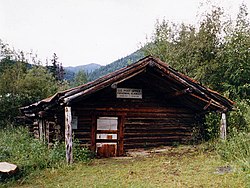Wiseman, Alaska | |
|---|---|
 The log-built post office at Wiseman, seen here in 1995, has been sinking into the ground for the past century, and is now a couple of feet below ground. | |
 Location of Wiseman, Alaska | |
| Coordinates: 67°24′34″N150°6′35″W / 67.40944°N 150.10972°W | |
| Country | United States |
| State | Alaska |
| Census Area | Yukon-Koyukuk |
| Government | |
| • State senator | Click Bishop (R) |
| • State rep. | Mike Cronk (R) |
| Area | |
• Total | 78.03 sq mi (202.11 km2) |
| • Land | 78.01 sq mi (202.05 km2) |
| • Water | 0.02 sq mi (0.05 km2) |
| Elevation | 1,181 ft (360 m) |
| Population (2020) | |
• Total | 5 |
| • Density | 0.06/sq mi (0.02/km2) |
| Time zone | UTC-9 (Alaska (AKST)) |
| • Summer (DST) | UTC-8 (AKDT) |
| ZIP code | 99726 [2] |
| Area code | 907 |
| FIPS code | 02-85610 |
| GNIS feature ID | 1414284 |
Wiseman is a census-designated place (CDP) in Yukon-Koyukuk Census Area, Alaska, United States. The full time resident population is 12 as of 2022.
Contents
Wiseman is a small mining community along the Middle Fork Koyukuk River in the Brooks Range. It was founded by gold miners who abandoned the Slate Creek (later Coldfoot) settlement around 1908. Another small mining village (Nolan, on Nolan creek - to the north) survived into the 1970s.
Robert Marshall, who became a prominent American forester, preservation activist, and a co-founder of The Wilderness Society, wrote the bestselling book, Arctic Village, about his 15-month stay in this frontier town around the year 1930. Marshall described Wiseman and the Koyukuk River area surrounding it, as "the happiest civilization of which I have knowledge." [3] Marshall called Noel Wien's first flight there on May 5, 1925, "one of the great events in Koyukuk history." [4] [5]
The community is 3 miles (5 km) from the Dalton Highway, and it was not connected to the road until the early 1990s.

